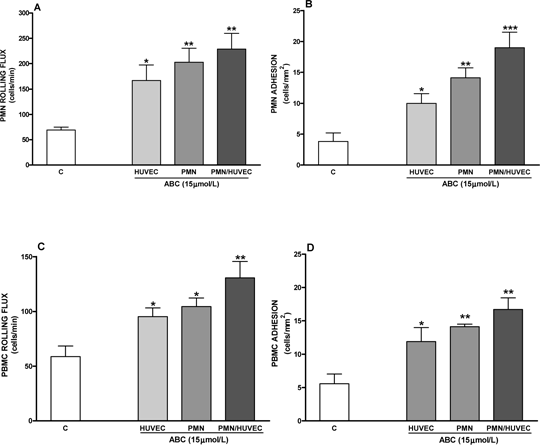Endothelial cells play a role in the leukocyte recruitment induced by ABC Background: Abacavir (ABC), one of the most widely used antiretroviral agents, has recently been associated with the development of cardiovascular complications such as myocardial infarction and atherosclerosis. In previous studies, we have demonstrated that ABC causes leukocyte-endothelial cell interactions through Mac-1 activation. Although constitutive ICAM-1 was involved in this process, we did not detect endothelial activation. Therefore, the aim of the present study was to further explore the role of the endothelium in this interaction. Methods: The interaction between human leukocytes - i.e., peripheral blood polymorphonuclear (PMN) and mononuclear (PBMC) cells - and human umbilical vein endothelial cells (HUVEC) was analysed in dynamic conditions using the parallel plate flow chamber system. In order to detect the potential involvement of endothelial cells in these interactions, we performed three experiments: two in which either HUVEC or leukocytes were treated with ABC (15 µmol/L), and a third in which both cell types were treated with the drug. In all three experiments, leukocytes were drawn into the chamber containing HUVEC. A second set of experiments was performed in ABC (1-15 µmol/L)-treated HUVEC in order to determine: 1) ROS levels [via fluorescence inverted microscope using dichlorofluorescein diacetate (DCFH-DA, a fluorocrome that detects total ROS)]; 2) translocation of NF-κβ to the nucleus (by Western blotting); and 3) endothelial expression of adhesion molecules (ICAM-1, VCAM-1 and E-selectin; by flow cytometry). All data were expressed as mean±SEM. A one-way ANOVA was followed by a Newman-Keuls post hoc test and statistical significance was *p<0.05, **p<0.01 or ***p<0.001 (vs. control). All experiments were performed in groups of n≥4. Results: A clinical concentration of ABC (15 µmol/L) induced a significant increase in PMN rolling (Figure 1A) and PMN adhesion (Figure 1B) and in PBMC rolling (Figure 1C) and PBMC adhesion (Figure 1D) at 4h in all three experimental groups, including the HUVEC-treated group. This demonstrates that ABC affects HUVEC and that this cell type plays a crucial role in the leukocyte recruitment induced by the drug. ABC induced a dose-dependent increase in total ROS levels in HUVEC at 4h (ABC 15 µmol/L: 158.0±14.8%*** vs. 100% control), in the translocation of NF-κβ inflammatory transcription factor into the nucleus at 4 h (ABC 15 µmol/L: 387.7±43.2%** vs 100% control) and in the expression of ICAM-1 at 24 h (ABC 15 µmol/L: 140.2±7.6%*** vs. 100% control). Conclusions: Endothelial cells are involved in leukocyte-endothelium interactions triggered by ABC. Their role could be due to an increased release of ROS, which leads to translocation of NF-κβ to the nucleus. This nuclear factor induces the transcription of genes and a subsequent traduction of mRNA in adhesion and/or proinflammatory molecules, which can activate endothelial cells and/or circulating blood cells and eventually lead to an increase in ICAM-1 expression in the endothelium. This process may be responsible for the leukocyte recruitment observed in the vascular damage associated with atherosclerosis and myocardial infarction in HIV patients treated with ABC. Figure 1: Effects of ABC on leukocyte-endothelium interactions.*p<0.05 and **p<0.01 vs. vehicle. One-way ANOVA followed by Newman-keuls post hoc test (n≥4). 
|

